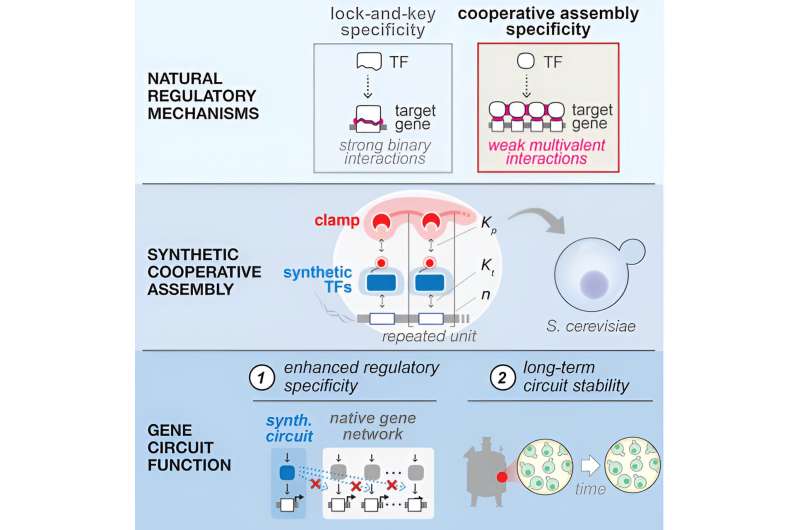This article has been reviewed according to Science X's editorial process and policies. Editors have highlighted the following attributes while ensuring the content's credibility:
fact-checked
peer-reviewed publication
trusted source
proofread
Weaker transcription factors are better when they work together

Bioengineers can tailor the genomes of cells to create "cellular therapies" that fight disease, but they have found it difficult to design specialized activating proteins called transcription factors that can throw the switch on bioengineered genes without occasionally turning on some of the cell's naturally occurring genes.
In a study published online in Cell, bioengineers from Rice University, Boston University, Harvard Medical School, Dartmouth College and Harvard University's Wyss Institute showed they could all but eliminate such "off-target" gene activations using a method that takes its cue from nature.
"We made our transcription factors weaker," said co-senior author Caleb Bashor, an assistant professor of both bioengineering and biosciences at Rice who helped lead the study. "Because they bind more weakly overall, the chances of their binding off-target drop to almost nothing."
In general, bioengineers have leaned toward designing strong-binding transcription factors to help ensure target genes get activated when they are supposed to. While weakening transcription factors seems counterintuitive, Bashor's research group has collaborated with the group of BU's Ahmad "Mo" Khalil for years to build and test tools that employ weaker transcription factors by making them work in teams.
"Transcription factors act as the 'wiring' in gene circuits by linking together the expression of different genes in the circuit," Bashor said.
Gene circuits are sets of genes that work together to perform a specific function. For example, in previous work Bashor and colleagues implemented circuits that performed programmable Boolean logic, signal processing, analog-to-digital conversion and other complex tasks.
Each transcription factor activates its specific target gene by binding with a particular sequence of DNA that activates that gene. Bioengineers can use one transcription factor to turn a particular element of a gene circuit on, for example, another to turn its output from low to high and yet another to turn it off.
To ensure that their weakened transcription factors activated their target genes when called upon, Bashor, Khalil and colleagues employed a phenomenon called cooperative assembly. In their cells, a transcription factor only activates its target by first merging with one or more other transcription factors to form a large protein complex. The assembled complex, behaving as a single unit, activates the target gene.
"Our design makes them strong as a group, but weak alone," Bashor said. "It ensures that the only genes they can get together to activate are the ones in the circuit. The result of this is gene circuits that work normally, but are also 'stabilized' and remain in the cell long-term."
Bashor said nature's use of a similar strategy in humans and in other complex life was an inspiration for the project.
To illustrate the work's potential, he used the example of cell-based therapies. In many, the number of engineered cells a patient receives is far fewer than the number needed to produce a therapeutic effect. Meaning, the treatment is only effective if the engineered cells thrive, reproduce and grow into a population that's large enough to take on the disease.
"Any burden imposed through off-target interactions lowers the odds of success," he said. "Our approach offers a generalizable set of rules engineers can use to insulate gene circuits from the host cell and mitigate off-target burdens."
More information: Meghan D.J. Bragdon et al, Cooperative assembly confers regulatory specificity and long-term genetic circuit stability, Cell (2023). DOI: 10.1016/j.cell.2023.07.012
Journal information: Cell
Provided by Rice University




















